Gerhard hermann Budde Free in Nordhorn
As indicated, the Budde family that lived in the 17th and 19th centuries in Wietmarschen was not ‘free’. But also in those days, for money everything was possible. However, this commodity was for most people, during many centuries, in very short supply! When Gerhard Hermann Budde (born 1731), son of Bernardus, left Wietmarschen for Nordhorn he surely had to pay money for a ‘Freibrief’ (passport) in order to become free and to have the chance to become a citizen of Nordhorn (which he became age 40, in 12.02.1771, as was recorded in the ‘Bürgerbuch Nordhorn 1396-1913’ (citizen book of Nordhorn): Gerhard Budden uyt het Wietmarschen. He most probably had to pay 12 Reichstalers for this privilege.
It is at this time that the Nordhorn branch of the family splits itself off from the branch that still lives in Wietmarschen.
In Nordhorn Gerhard marries on 13 May 1770, at the age of 38, Maria Wolterink, aged 35. The wedding was conducted by father J.W.Zumbrock at the church at the Burginsel. It is interesting to speculate what happened. Despite his age, there is no indication that Gerhard was married before. Maria was also middle aged, itd oesn’t like she was a widow, as no children are mentioned? Was their a relationship between these two families?
Iit could well be that Gerhard was assisted by the Wolterink family in obtaining citizenship, historic documents in Nordhorn indicate that citizenship was normally only granted to people who had lived in Nordhorn for a long time. Could it be that Gerhard moved in with her family and later became an owner of a house here that had belonged to the Wolterink family?
Gerhard and Maria had two children a son Johann Bernhard (born in 1771) and a daughter Elizabeth (born in 1772). In a document dated 1813 we come across Johann Bernhard under the name of Berend as one of the inhabitants of the Burgstrasse, next-door to Wim Nicolaus Wolterink and the widow of Franz Wolterink. The Wolterink family are mentioned in documents from these cities as barbers and watchmakers.
In a document from 1871 the Budde and Wolterink properties are mentioned as being in this street when they burnt down in a fire. This fire was not the only disaster that struck the family. A year after Gerhard’s arrival in Nordhorn, the River Vechte broke, through its banks at the Burgstrasse and led to one of the worst floods the city had ever encountered. During the nights of 12 and 13 January 1772 the water rose to shoulder level. In 1846 the river again flooded at the Burgstrasse. Only after further canalisation and the construction of the Nordhorn-Almelo canal in 1900, did major flooding become a thing of the past.
Gerhard however, was not the first Budde to live in Nordhorn. In an overview of landowners from 1661 ‘Die Budde, Berevens Meijer’ are listed in Altdorf, the original farming settlement of Nordhorn. The farm size was 5 Mudden and 48 Rode. In 1689 the family consisted of 2 men, 2 women and 5 children.
The catholic community of Nordhorn
Unlike Wietmarschen, with its monastery, Nordhorn was very much affected by the Reformation and had, when Gerhard arrived, only a small Catholic community existed around the St Augustan Church at the Burginsel. Approximately 17% of the 1,000 inhabitants of Nordhorn belonged to the Roman Catholic church.

Signatures of Friedrich Budde and Johanna ten Bokum and their parents. Left bridal couple. Right: Johan Bernhard Budde Nordhorn (1809-1875) and Anna Kock Nordhorn (1764-1848) Jan ten Bokum Ootmarsum (?) and Aleida Vinke Ootmarsum (1806-?)
Gerhard’s son, Berend married in 1794 his ‘free born’ wife, Anna maria Kock. Berend and Anna received citizenship in 1796. The entry in the citizen book is as follows: ‘Berent Jan Budde Fur seine Frau Marija Kok, freigeboren in Brandlecht.’
They had six children, five sons and a daughter. Two of their sons died young, Hermann Bernhard at the age of 17 in 1816 and Johan Henricus at the age of 9 in 1822.
There are good reasons to believe that the Catholic community of Nordhorn was closely-knit. A reference to this could be the fact that at the birth of Berend and Anna’s son Friedrich Anton Budde in 1807, Sophia Brück is mentioned as the Godmother of the child.
The big textile companies in Nordhorn which existed until about 1985 were founded by members of the families Brück, Kistemaker and Povel. They were all important members of the small Catholic community and were all linked together through marriages. They were in one way or another related to the daughter of Andreas van Wietmarschen. He came from Wietmarschen and became a citizen of Nordhorn in 1718. His daughter Anna Susanna (Nordhorn 1723-1806) married Antoni Kistenmaker. Originally from Zwolle, and involved in the transport business, the Kistenmaker family lived in the Burgstrasse.
The daughter of Antoni and Anna Susanne, Anna Gesina Kistemaker married Johann Anton Heinrich Brück from Osnabrück. Their daughter Sophia (1790-1837) became the godmother of Friedrich. To finally complete the picture of this closely-knit community, she married Joseph Povel in 1820.
Another interesting link here is that the father of the wife of Andreas van Wietmarschen, Gerhard Tenvrehde came from Ootmarsum. He was born there before 1648. This family is in its turn related to the family of the wife of my colleague researcher Rolf Suewolto.
Friederich’s godfather Anton Mähler is mentioned in the following story.
The Burgstrasse
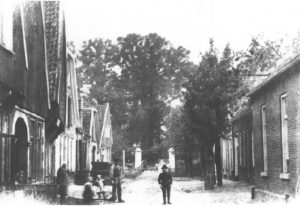
The Burgstrasse was the main street leading from the township to the Burginsel. Most probably by 800 a small watchtower existed there to protect the trade route of the counts of Bentheim. The name Nordhorn (originally Nodehorne), could well come from the warning sound (nood) of the horns used at this tower. The place received its city privileges in 1379 and it is most probably around this time that the tower was extended to a stronghold. Apart from its defensive function the site was used as a hunting castle for the counts.
The settlement was used by the Johanniter monks and in 1578 was sold by Count Arnold II to the Monastery of Frenswegen (this monastery was in 1809 handed over to the church of Ootmarsum). The Augustine monks rebuilt the ‘burg’ into a residence and a chapel, from now on known as ‘Klosterburg’. It was used during the 80-year freedom war of the Dutch against the Spaniards as a refuge for Dutch Catholics. After the reformation the ‘Klosterburg’ was classified as a Catholic building and the Catholics were thus able to continue to practise their religion. In many other places in Europe far less tolerance existed between the two communities.
A good example of this tolerance was the local school. Already in 1465 a school existed next to the church at the Burginsel. Until 1834 this remained the only school in town. Both Catholic and Reformed children were educated here. It was not until that year that a new Reformed school was built. The Budde kids didn’t have to travel far to go to school. In that same year full Catholic traditions were reinstated at the one-class, 86-pupil old school under the supervision of head-teacher J.H Heymann. A separate girls’ school was opened in the Burgstrasse in 1883.
In 1712 the chapel became too small and a separate church was erected next to it. The monks left the Klosterburg during the French occupation and the place was sold in 1811 by the French government to Magistrate Weber and businessmen Mähler and Brück, all three devout members of the Catholic community. The residence was used as a warehouse to stock salt. In 1824 the church was officially acquired by the Catholics. During the industrialisation of Nordhorn the Catholic community received a real boost as all key textile manufacturers belonged to this religion. As a consequence a new ‘big’ church was built in 1908 on the site of the old
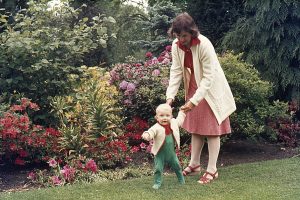
Burgkirche (castle church). Throughout the history of Nordhom the Burgstrasse has been the focus of the Catholic community. It is therefore not unusual that Gerhard Budde settled in this street after his arrival from Wietmarschen.
The chapel, the old and the new current church were all called the St Augustinus Kirche. It was in this church that the Buddes were baptised, got married and finally were farewelled from this church at their funerals.
Early pictures from the Burgstrasse show the gates that led to the bridge that went over the Vechte to the castle. The site is now a beautiful park. At the time the Buddes arrived in Nordhorn the current Hauptstrasse didn’t exist, the other main street in the Altstadt was the Ochenstrasse.
The French occupation
The Buddes in Nordhorn lived in very interesting times. The French Revolution and the ensuing campaigns of Napoleon would change the structure of Europe forever. The French ended the 1,000-year-old feudal system of both church and secular rulers. There was of course a running-up of these times as we have seen in Wietmarschen; also the fact that Gerhard moved to Nordhorn – be it just before the Revolution – and bought himself freedom was a sign of times. The French reformed the legal system, civil government. Democracy was introduced, as was conscription and the metric system.
After the French had successfully beaten English, Prussian and Hannoverian troops in 1793, the French fought back and very quickly conquered large parts of Europe. French troops arrived in North Germany in 1795 and the first troops were quartered in Nordhorn in March of that year. (In Wietmarschen French soldiers were billeted at the Budde farm.)
On the 17th of November 1813 the Russians arrived in Nordhorn and took over the local government. Most of the old monarchy systems were restored, after the collapse of the French rule, at the Vienna Congress (September 1814-June 1815). Once more Count Ludwig of Bentheim tried to get his way to re-establish his county, however the Congress ruled that it was part of the Kingdom of Hannover. It would take nearly another century before these old powers were finally dissolved. However, the seeds of change were clearly sown and very few of the powers were able to continue to rule without the involvement of representatives of the population. Most changes set in motion during the French occupation were in one way or another continued after the French had left their occupied territories.
Burgschenke – Domspatz
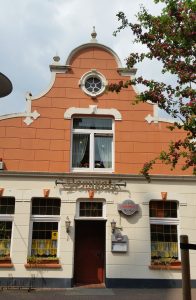
In Nordhorn in the Burgstasse, just outside the age-old Burginsel, on the other side of the River Vechte Gerhard’s son, Johann Bernhard (Bernd) Budde (born 1771) and his wife Anna Maria Elisabeth Kock opened an inn which was in the 1960s known as Burgschenke. After is was sold by the Budde family the inn was renovated and its name was changed into ‘Domspatz’.
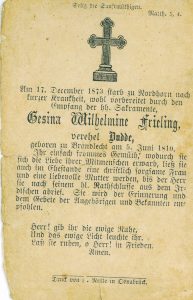
The freedom to choose your own profession that was acquired during the a French occupation led to the establishment of increasing numbers of ‘Bier und Schnapslokale’ – from 9 in 1810 to 26 in 1823 and even 30 five years later. Johann will therefore have faced stiff competition. This development is clearly an indication of an economy in recession, lack of jobs forced people to set up their own little shops. The mayor of the time was obviously worried about a development that led to a pub or small inn on virtually every corner of the streets in his town. The 1,200 citizens consumed annually between 160-200 ohm (approximately 30,000 litres) of corn-brandy.
This increased the incidence of small crime in town, mainly break and enter. In a report from 1812 we read that the quality of the local beer is appalling and that this is the reason for the high consumption of the excellent corn-brandy!
In a house list of 1813, house number 88 lists Berend Johann Budde as the owner of one house. Berend’s son, confusingly also baptised Johann Bernhard (born in 1809), marries Gesina Frieling in 1841. As they were both related in the 4th degree they had to ask for dispensation. In 1842 both were written into the citizen book. The entry for Gesina is as follows: ‘Frau des Schankwirts Johann Budde, Wilhelmina Gesina Vrielink aus Brandlecht.’ An indication that he was already the inkeeper (Schankwirt) at that time. His father died in 1853. Gesina’s father Bernhard Frieling was the local blacksmith in Brandlecht.
Brandlecht
The majority of the people in Brandlecht belonged to the Reformed religion. The catholic enclave of people who owned land (“Eigeners”) or who were “Pachters” in Brandlecht, was concentrated around “Burg Brandlecht” on the so called “Hofesaat” . This was owned by the “Freiherr von Reede zu Brandlecht” and later on by “von Droste-Vischering. The families Frieling, Kock and Hillen all belonged to this catholic community.
These owners were catholic and let the community build a little catholic church on their grounds. The birth record of Rolf Suewolto’s grandmother Schlothaus, who came from Brandlecht, shows that she was born on the “Hofesaat Brandlecht”.
Johann and Gesina had 4 children; two of them died at a young age. Johann Bernhard was 2 years old and Heinrich only 1. From the other two, Bernhard Heinrich (born in 1846) continued the inn. The other son, Gerhard Hermann (born in 1848), moved in 1871 to Ootmarsum.
Bernhard Heinrich lived with his parents at the inn at the time of the fire that destroyed the building on 8 September 1871. A report on the fire mentions the inn was owned by ‘Wirt’ Budde. Bernhard was at that time a shoemaker and gardner.
Bernhard Heinrich was 34 when he married in 1880 Christina Maria Hillen (born in Emsburen -Engden on 30 October 1851). They are listed in 1884 in the citizen book: ‘ Schankwirt Bernhard Heinrich fur seine Frau Christina Maria Hillen aus Engden (48 Mark)’. Bernhard became the next innkeeper until his sudden death in 1885. His his wife remarried with Heinrich Bernhard Schomakers. He becomes the next Schankwirt. They had one daughter, Bernhardina, who died unmarried.
The Schomakers family arrived in Nordhorn from Lohne around 1834. In that year Johann Gerhard Shomakers (Heinrich Bernhard’s father) was mentioned as a blacksmith and a citizen. Since 1886 they lived in the Burgstrasse. The local ‘Arbeiter und Soldatenrat’ in Nordhorn was initiated in their house in 1919.
These Labourers and Soldiers Councils were formed during the so called November Revolution in Germany. At the end of WWI when the armies and their empires collapsed, disillusioned soldiers and labourers, who were used as canon fodder during the war – and particular at the very end of that war when everybody could see that the war had been lost – started to take control of their own affairs, they basically ‘walked of their jobs’ and went home. They started to form these Soldatenrats, modelled on the ‘Sovjets’ (=Councils) in the Sovjet Union where such councils were formed after the empire collapsed here in late 1917. After the German and Austrian empires imploded a year later, similar Councils were established in these countries. In January 1919 this ‘communist’ movement was bloodily suppressed by the so called ‘Freikorpsen’ this revolution ended when the Weimar Repbublic was formed later on that year.
The Hillen connection
As we saw above Bernhard Frieling, the local blacksmith in Brandlecht, married in 1809 Susanna Helena Gilbers (Hilbers/Gielbers). Their daughter Gesina Frieling married Johan Bernhard Budde in 1841. Their sons include Bernhard Heinrich Budde, who takes over the Domspatz inn from his father and my great-grandfather Gerhard who moved to Ootmarsum.
Back to Bernhard Frieling, he dies in 1809 and Susanna remarried with Bernhard Hillen who also took over the forge. The Hillen’s remained the local blacksmiths till at least 1880. Records from that year lists: “Pachter und Schmied Hillen”. Other documents mention him as “Schmiedemeister”. He is also mentioned as “Heuermann in Nordhoffheuer”. Translated this means “hired hands at farmer Nordhoff“. According to Rolf’s information he rented a house in Engden from a farmer called Nordhoff and he most probably had to work for him for a defined time.
One of their children was Bernhard Heinrich Hillen who married Maria Roling in 1843. They had a daughter Christina Maria who in 1880 married Bernhard Heinrich Budde (the innkeeper)!
At the last visit in 2000 a Peter Hillen is the innkeeper of the Domspatz, however so far we have not been able to link him into this family network.
The year 1848
As mentioned before, the French Revolution was the first major experience by most people of the concept of democracy and personal freedom. However, after the Vienna Conference the power returned to the numerous monarchs. The next ‘revolution’ started in 1848. It was the year that Gerhard Hermann was born on September the 30th. Earlier that year his grandmother Anna Maria died on the 25th of January.
Most European countries were in uproar around this time.
It all started again in France with yet another bloodbath, the ‘new’ monarchy gets overthrown and King Louis Napoleon gets elected as president. Lots of European countries wanted to rid themselves of their monarchy who clung on to their powers without any involvement of their citizens in the day to day governing of their countries. The February revolution in France spilled over, especially to many countries within the Austrian-Hungarian Empire. There are civil wars in Czech, Poland, Hungary and Switzerland. There are uprisings in Italy (Sicily). In Prussia the Constitution is introduced, providing the first little bit of democracy to its citizens.
Nordhorn is also affected by this democratic fervour. The people in the German-Dutch border area had always been known for their independent stand, and they didn’t like to be told by others what to do and what not to do.
In 1848 the whole population united around the concept of a unified Germany. Ending the unruliness of the 300 smaller states and cities who all made their own little rules, regulations, tax systems, foreign politics, etc. Flags and banners were carried through the streets of the town and there were peaceful demonstrations in front of the town hall. This sometimes clashed with the local government who still had to adhere to the rules of the local monarch – in Nordhorn’s case the House of Hannover. One of the banners from 1848 is still kept locally. The slogan of the year was: ‘Eendracht maakt Magt! Revivat Nordhorn.’ (Unity is power! Revive Nordhorn). It is interesting to see that the Catholic community in particular played a key role in this process of unification. The Kistemakers and Brücks are among the leaders.
The Marzrevolution of 1848
|
The failure of the Marzrevolution was a turning point in nineteenth century German history, The aims of the rebellion were political and economic reform: · the unity of the various German States; · free parliamentary elections; · freedom of the press; · a written constitution; and · the establishment of a ‘Bill of Rights. The rebellion was precipitated by- a number of actors: the example set by the revolutionary assaults on autocracy represented by the American Revolution-of 1776, the French Revolution-of 1789, and the subsequent French rebellions of July 1830 and February 1848. Furthermore: · the emergence of a large and impoverished industrial working class; · the domestic political repression exemplified by the military response to the 1844 rebellion of Silesia weavers in search of cheaper food and better wages; and · the famine and starvation produced by the crop failures of 1847. It was initially, successful, leading to major concessions by the Prussian King Friedrich Wilhelm IV, but lost momentum because of disputes between its liberal and radical factions and the counter-rebellion of the Prussian aristocracy (backed up by the military). ln April 1849 the king WAS offered the crown of emperor under a new constitution. |
It is not known how the Buddes reacted to this. However, when it in the end came to a confrontation, whereby Prussia fought its independence war against Austria, Gerhard Hermann fought on their side.
Der Altkrieger
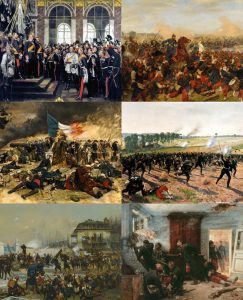
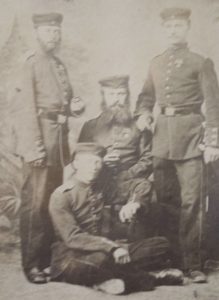
Born in the revolutionary year of 1848, it must have been an omen for him. At the age of 18 he first fought in the victorious Seven Week War. In 1867 the Prussian military leader Otto von Bismarck defeated Austria and was thus able to unite northern Germany. Three years later, Gerhard was present again when more German history was written during the Franco-Prussian war of 1870/1871. Von Bismarck used am international event as an excuse to challenge the French to declare war on Germany. (The immediate cause of the Franco-Prussian War was the candidacy of Prince Leopold of Hohenzollern-Sigmaringen for the Spanish throne, which raised the possibility of a combination of Prussia and Spain against France.) France took the bait and Germany crushed their armies. Von Bismarck was now also able to also unite the southern part of Germany. On the 1st of January 1871 Germany as we know it today was finally pronounced. At the Treaty of Versailles the Prussian King Wilhelm I was crowned as the German Empire.
On his return from this war he moved to Ootmarsum where he married my great-grandmother. He apparently often told family and friends about his participation in the Franco-Prussian War as he became known amongst them as Der Altkrieger (The Veteran)
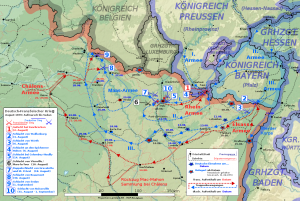
Another interesting detail is that the German philosopher Friedrich Nietzsche was also conscripted into this war. This certainly also had an influence on some of his thoughts about war, ideology and issues such as use and misuse of power. (See Master and Slave Morality)
Memorabilia France – Prussian War 1870 – 1971

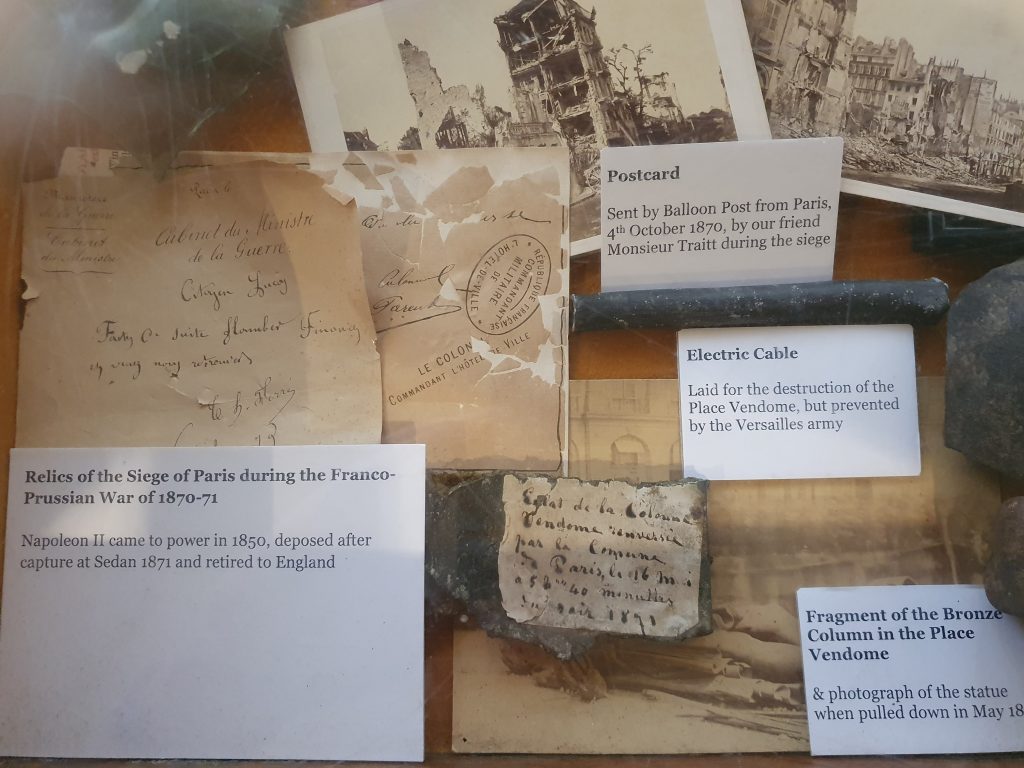
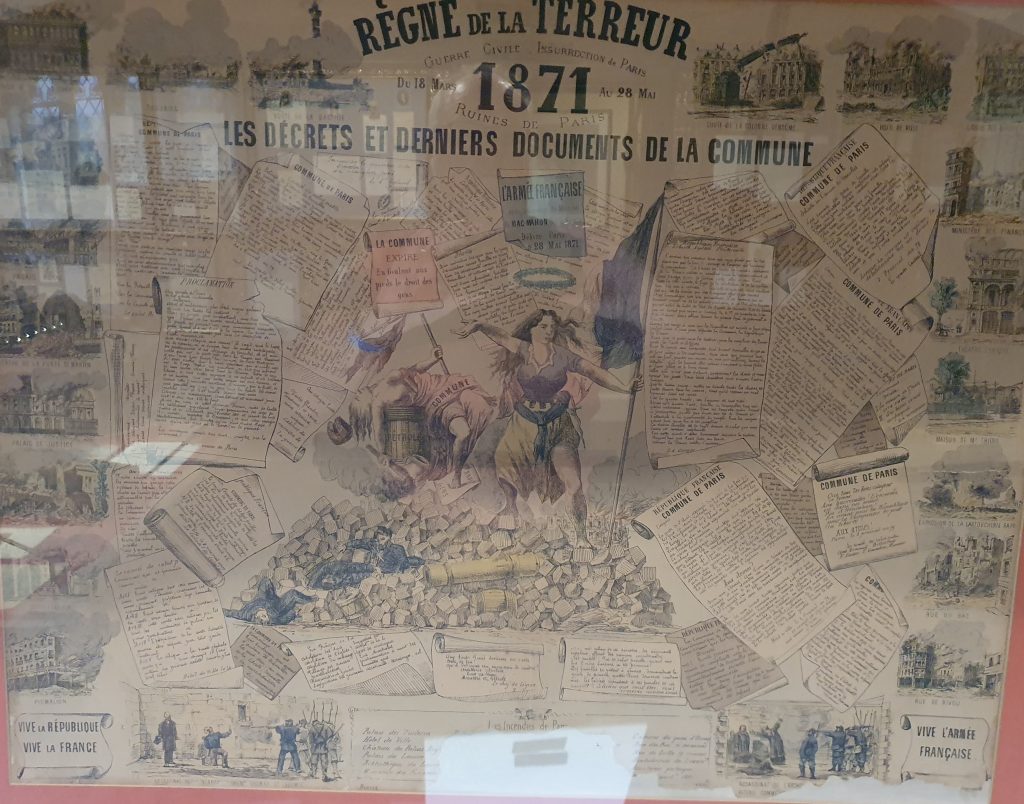
The above three pictures were made in September 2022 and are from a display in Sudeley Castle in the UK. Here Emma Deny (1823-1900) has an enormous collection of information that she collected during her lifetime. During the Siege of Paris, Emma’s cousin Alice and her family were trapped here and her husband brought these items back with him to the UK
Unfortunately the Prussian rulers were much better at warfare than at democratic government, the Constitution of 1848 had not delivered the level of involvement in governing demanded by the people. A very conservative policy following the unification in 1871, alienating most people from their politicians. At the beginning of the 20th century the foreign policy of Germany had virtually collapsed and the country became internationally isolated. In the following two World Wars we see our own Buddes on both sides of these ugly wars. Because of his resistance activities, my father Herman Petrus (1920 – 1977) ended up in the concentration camp of Vught. And the Buddes in Wietmarschen suffered two terrible war losses, Josef dies on a French battlefield in 1915 during WWI and Johan in Russia during WWII in 1944.
The last 100 years
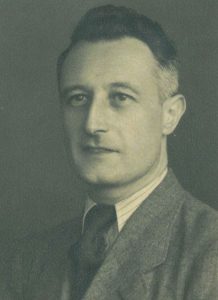
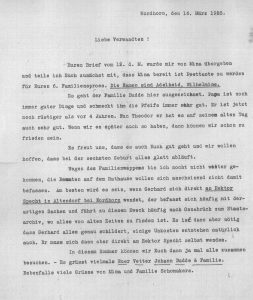
Research regarding the Budde family that stayed in Nordhorn during the last 100 years has so far provided only meagre results. Theodorus Budde from Ootmarsum had some correspondence in 1928 with his family in Nordhorn (vetter Johann Budde und family, perhaps a son of Bernhard Heinrich?). The letter from Nordhorn was signed: Mina und Familie Schomakers.
Rolf Suewolto’s mother, who lives in Nordhorn, recalls that Johann was a head clerk at the local textiles plant NINO (formerly Firma L. Povel).
Povel
The Povel factory (est. 1872) has also another link with our family. During WWII my father Herman Budde was send as a forced labourer to Germany. While I can’t find any direct evidence I assume that thanks to the Budde relations in Nordhorn he was placed closed to the border in Nordhorn where he was employed by Povel.
Eventually this factory followed the fate of so many other textile companies in Europe and finally in 1978 went bankrupt. A few building survived one of them is the Povelturm, which now functions as a museum.
According to her there were also a Heijn Budde and a Mina Budde. This last person, Gesina Wilhelmina Aleida (Mina) Budde is however, the only child of whom I do have an official link back to parents Bernhard Heinrich and Christina. She was the owner of the inn until her death in 1970 (?).
Johann had three daughters, all born between approx. 1918 – 1922: Christine (Tini), Maria (Mia) and Elisabeth (Lisbeth), she died when she was 14 years old.
However, since 1957 the inn was already leased out. The following leaseholders are recorded:
Anni ter Duis 1957 – 1970
Ranco Solic 1971 – 1976
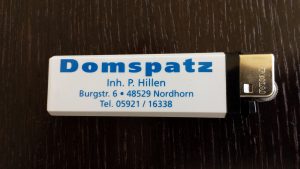
Johann’s daughter Mia was the last Budde owner of the house and the inn since 1970. In 1976 she sold the house and inn to Helmut Fehren (an insurance agent). Ending a period of 200 years of our family in Nordhorn. The new leaseholder was Gunter Their. In 1986 the inn was sold to Rolinck-Brau and the leaseholder since that year has been Peter Hillen (no family of the Hillen’s related to the Buddes).
In 1971, a family reunion of the descendants of Gerhard Hermann Budde took place in the inn to celebrate the 100th anniversary of his move from Nordhorn to Ootmarsum. Mia Budde was also present. Unknown to the reunion at that time was the fact that that year also heralded the 200th anniversary of the arrival in Nordhorn, of our branch of the Budde family.
In the 1970s there was still an Elisabeth Budde living in Nordhorn. She could have been a descendant of Antonius Lambertus Budde (born 1804) the third child of Johann Bernhard and Anna Maria. Another Budde (grave at the catholic cemetery) that I have come across is Josephine (1908 – 1982?). Other Budde’s at that same cemetery. As per the cemetery monuments:
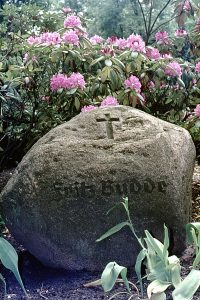
Hollman Budde, Hendrikien Hollman ver ww Budde, geb. Busman 3-9-1887 – xxx194x
Gerhard Herman Budde short story
(source video disc 23)